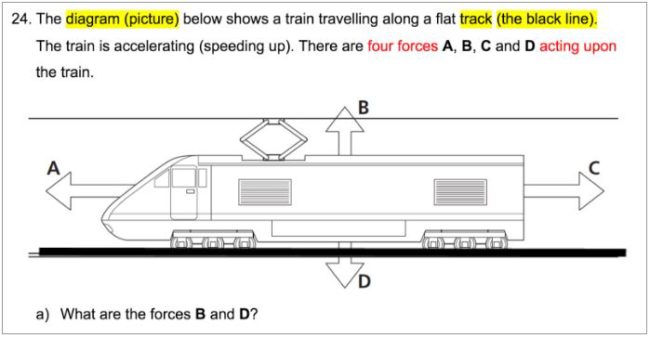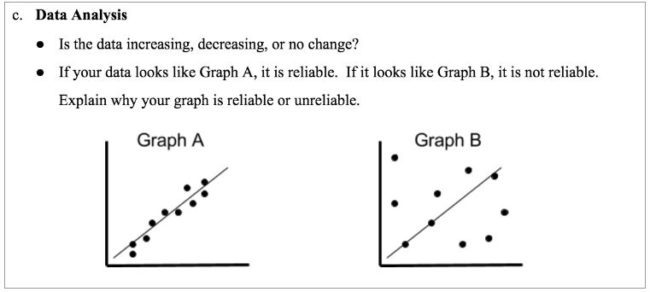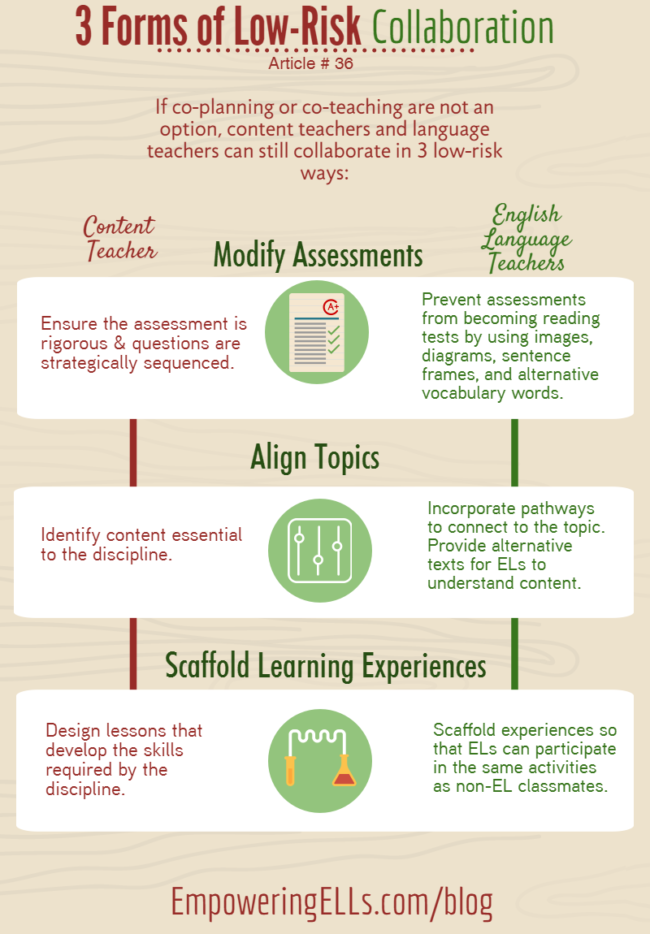This article on collaboration between content and English language teachers is Part 17 of WIDA’s Essential Actions Series. Click here to read the first article in the series.
When I first started my teaching career, I nearly always worked alone. I had been taught few effective teacher collaboration strategies and no example to follow. While other educators and I were always friendly and often went to school athletic events together to cheer on students, that was the extent of our interaction.
A decade later, it seems that collaborating is half of my job description. My principal schedules meeting times for content teachers and I to co-plan instruction, co-create assessments, and establish co-teaching structures.
WIDA’s Action 14 from their Essential Actions: A Handbook for Implementing WIDA’s Framework for English Language Development Standards (Gottlieb, 2013) encourages collaboration between content and English language teachers (ELTs). Gottlieb writes that, “Teachers have to share responsibility, coordinate instruction, and engage in a cooperative process to reach common goals for their students” (2013, p. 64). Cooperation consist of two parts: co-planning and co-teaching to ensure that ELs learn content in tandem with developing language skills (Echecarria, Vogt, & Short, 2008).
That’s all well and good. But what do you do when a content teacher really isn’t interested in co-planning or co-teaching with you? If they’re not that interested in the benefits of teacher collaboration? Luckily, there are several ways to collaborate with content teachers who are comfortable taking different levels of risk in sharing their classroom. We’ll examine three examples of one-off collaboration today.
The Pool as a Metaphor for Collaborating
Collaborating is like a swimming pool that sinks to different depths depending upon the ability of the swimmer. Beginning swimmers start off in the shallow end and gradually become more comfortable being in the water. Beginning collaborators should likewise begin with simple modifications of a content teacher’s assessments.
As a swimmer’s confidence builds, we urge them to leave the shallows and enter a deeper part of the pool – aligning topics with the content teacher and scaffolding students’ learning experiences. Finally, when their confidence is fully developed, we encourage them dive into the deep and fully co-teach with their peers.
Modify Assessments
When working with content teachers who are resistant to co-planning, start with the least threatening place: modifying assessments.
Content teachers who withdraw from collaboration often want to retain control of the instruction. These teachers are more willing to let go of the teaching when administering assessments, which doesn’t involve direct instruction. I have found that as our relationship grows, I’m then invited to co-plan lessons and gradually even co-teach alongside the content teacher. Modifying assessments is the first step to establishing this positive relationship and helping your peers appreciate the importance of teacher collaboration.
To begin, the content teacher designs the initial assessment because she is most familiar with the content. Then we discusses ways to scaffold the assessment. Collaboration ensures that ELs understand the instructions, so that it doesn’t become a reading test . Some helpful modifications to assessments are:
- adding images, diagrams, graphs
- providing a content vocabulary word bank without defining the vocabulary words
- using sentence frames
- intentionally sequencing questions from easiest to most difficult
- allowing for multiple choice
- offering more accessible vocabulary in parentheses after a difficult academic word as seen in the image below. As the red words are the content vocabulary for the unit, so they are not modified.

Notice how the content remains the same, but the wording changes. These modifications don’t make the work easier. They make instructions more accessible .
Align Topics
If collaborating to modify assessments is considered stepping into the shallow end of the pool, then content alignment is wading further into water.
Content alignment means that the content teacher and ELT cover the same topic but in different ways. It involves some in-person co-planning to align the content-specific topic with language instruction. However, the language teacher doesn’t go into the content teacher’s classroom to offer support.
First, the content teacher and ELT meet to discuss what topics will be covered in the content class. Each teacher should understand what aspects of the topic to explore, what resources will be viewed and read, and what learning experiences students will be engaged in.
Next, the ELT considers what pathways she can use to connect to the topic. These pathways become the context for using language during her English class.
When Mr. D discussed access to water in Africa for a 7th grade unit, I decided to use our local context and teach about access to water in Laos. We read an article, watched a video, and interviewed local villagers about the topic. Aligning the content allowed our ELs to build a more established schema of the topic because they had two distinct examples to draw from.
Another way to align English lessons with content classes is by studying the same topic but providing alternative texts. ELTs can offer modified articles or videos that are more appropriate for an EL’s language level. The text ELs engage with isn’t as important as the thinking they developed from interacting with it .
Aligning topics directly supports ELs in seeing the connections between two disciplines. Since both disciplines are providing different content and perspectives around the same topic, this form of collaboration expands ELs’ body of knowledge, presenting more opportunities to make connections. Making connections is an indicator of critical thinking.
Scaffold Learning Experiences
The next phase of the adventure is scaffolding – submerging just a little more into the deep but still keeping your head above water.
This form of collaboration involves the content teacher and ELT co-planning the learning experiences. It requires more in-person planning, which can meaning meeting on an ongoing basis. While it requires more time, scaffolding often results in greater academic gains for ELs due to the depth and breadth of the collaboration. For more information on teacher collaboration and student achievement, read Andrea Honigsfeld and Maria Dove’s book entitled Collaboration and Co-Teaching: Strategies for English Learners.
Scaffolding begins when a content teacher meets with an ELT to explain the objective of a particular lesson. The ELT listens, asks questions, and offers some EL-specific suggestions.
I recommend framing the suggestions just for the ELs and not for all students so as to not offend the content teacher who may feel that we’re critiquing the lesson itself. Even the slightest criticism can end a productive relationship when it’s perceived as a judgement on the quality of the content teacher’s skill. While making content language more accessible does benefits all learners, it’s important to allow time and space for the content teacher to expand into this realization on their own pacing.
Mr. A, a science teacher, and I collaborate on designing EL-friendly learning experiences all the time. During the co-planning of an experiment on forces, we identified that the “Data Analysis” section was the most challenging for ELs because it is so abstract. I recommended that he use images to communicate the meaning of reliable and unreliable data. and created these two charts to help him teach these concepts. Mr. Arno decided to integrate them into a modified lab report created specifically for ELs.

Scaffolding is the last phase of collaboration before diving head first into the deepest end: co-teaching.
If scaffolding is successful, there’s a greater chance for the content teacher to invite the ELT to co-teach and vice versa. Co-teaching is a natural progression from collaborating at the lesson planning level. The content teacher and ELT are used to collaborating over the daily activities – not just over planning broad aspects of the unit.
Takeaways
Now that teaching is becoming more collaborative, especially for language teachers, we have to be intentional about the way we collaborate. Because the majority of educators are most comfortable teaching alone, collaborating can be an unfamiliar, anxiety-producing experience.
Language teachers have to form a positive working relationship first. The approach that I have shared here paves the way to full collaboration, leading to co-planning and co-teaching.
Next Post
The next post is the final article interpreting WIDA’s Essential Actions. Continuing on the theme of collaboration, we’ll look at how language educators can helping content teachers care for ELs by being aware of the language demands of their discipline. I will share specific aspects of literacy that content teachers can be aware of when instructing ELs.
Echevarria, J., Vogt, M. E., & Short, D. J. (2008). Making content comprehensible for English learners: The SIOP® model (3rd ed.). Boston: Allyn and Bacon.
Gottlieb, M. (2013). Essential Actions: A Handbook for Implementing WIDA’s Framework for English Language Development Standards. Madison: Board of Regents of the U of Wisconsin System.


